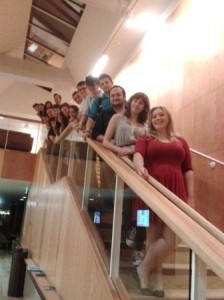This year’s student conductor, Matt Bamford, reflects on recent rehearsals.
With only eight more weeks until our annual concert in the Crypt of Canterbury Cathedral, our programme is really beginning to come together and the ensemble sound develop.
Reflecting on our first two rehearsals after the Christmas break fills me with great excitement. It was really difficult to predict how the first rehearsal back would go, with the choir not having sung together as a full group since the University Carol Service at the beginning of December. On top of this, much of the Crypt repertoire had not been rehearsed since late November and so returning to it could have been like starting from scratch again.

Matt finish…
The first piece that we looked at was Chilcott’s arrangement of Steal Away; a very colourful piece that is driven by supported breathing and the motion of the sustained pedal notes in the male parts. To this end, we began the warm-up by lying on the floor and doing some very long breathing exercises. The idea of lying down to do this is that it encourages you to breathe from your diaphragm and directly from there rather than your chest. The sound of the ensemble had stuck from before our long break, and the colourful chords really pierce the great acoustics of the Colyer-Fergusson hall where we rehearse.In complete contrast to the tranquil Steal Away we have also spent time rehearsing Rutter’s arrangement of Dashing Away with the Smoothing Iron and Lassus’s playful Rooster-Fight Chi Chi Li Chi. Dashing Away is deceptively difficult in terms of rhythm, and we spent much of last night pulling the first three verses apart making sure that each part had the confidence to attack each rhythmic phrase. After debate over whether to sing “Dash-ing” or “Da- shing” and making sure we don’t sing on the beat during syncopated sections, we began to bring the piece up to performance pace, which filled me with lots of excitement. It is such a playful piece!
We made more progress with Chi Chi Li Chi which can only be described as a piece like no other that I have performed before. Telling the story of a Rooster-Fight through singing and other vocal noises (come along to the Crypt and you will understand more…) is great fun, but also very challenging. There are constant meter changes and the opening section has a rather lethargic feel to it.
As we are now beginning to rely on the piano much less, we can begin to pull pieces apart and the choir are really growing in confidence. We have an all day workshop ahead of us, which will be another opportunity to bond as a choir and to develop the unique sound that we are already producing.
Eight weeks, and counting!
Matt Bamford


